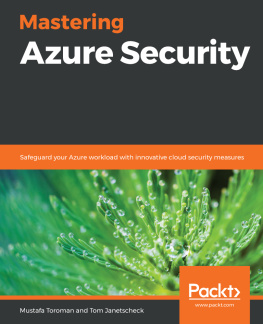This book is dedicated to the medical professionals who have helped restore my healthwho have listened to all my woes and found ways to address them. Yes, I did need to follow the advice, but they were the ones who offered it. Good health is an exceptionally grand gift.
Preface
Ransomware, viruses, distributed denial-of-service (DDoS) attacks, man-in-the-middle attacks, security breaches, and the like all bring to mind the one thing that anyone involved in managing applications hatesnightmares. It gets to the point where anyone who does anything to affect the security of an application or its associated data becomes gun shyconservative to the point of absurdity. You dont actually want the responsibility for securing the applicationit just comes with the territory.
Adding to your burden, the disastrous results of any sort of mistake could haunt you for the rest of your life. Unlike most mistakes, you likely wont sweep this one under the carpet either, because itll appear in the trade press where everyone can see it. Even if your name doesnt become synonymous with security failure, there are always the ramifications of a security issuelegal woes, loss of job, and so on. So, how do you deal with this issue?
Hiding your head in the sand doesnt appear to provide a solutionat least, not for very long. Security for Web Developers isnt intended to tell you about every threat out there or resolve every security woe youll ever encounter. Instead, it provides you with guidelines and tools you need to resolve any security issue on your ownto be able to see a light at the end of the tunnel that doesnt have something to do with a train. What this book is really about is being able to get a good nights sleep knowing that you have what you need to get the job done right.
About This Book
Security for Web Developers provides you with the resources you need to work through web application security problems. Yes, you also see some information about platforms, because browsers run on specific platforms. In addition, you might see some of these security issues when working with desktop applications simply because the security landscape occupies both application domains. However, this book focuses on security for web applications, no matter where those applications run. You can find information on everything from the latest smartphone to an older desktop, and everything in-between. The book breaks the information into the following parts, each of which takes you another step along the path to creating a better security plan for your organization:
Nothing works well without planning. However, some of the worst disasters in the computer industry occurred due to a bad plan, rather than no planning at all. This part of the book helps you create a good security plan for your organizationone that considers all the latest user devices and user needs as part of the picture. This part of the book also discusses the need for third-party support, because lets face it: the complex security environment really does make it hard to create a secure environment alone. The materials help you locate the right sort of third-party help and ensure you actually get the value you need from it.Creating applications today means relying on third-party code found in libraries, APIs, and microservices. This part of the book helps you consider coding issues. You wont find bits and bytes for the most part, but instead find helpful tips for incorporating these elements into your application successfully. This part of the book helps you manage your applications, rather than allowing them to manage you.You have a number of ways to test applications and a number of means to do it. For example, you can create your own test suites or you could rely on one produced by someone else. A third party could do the testing for you. Perhaps you want to know how best to combine different strategies to ensure you have your entire application covered. This part of the book answers all your questions about modern testing strategies and details what you can do to make your efforts more efficient.At some point, your application is in production and running smoothly. Some applications continue to run for years this way without getting the proper maintenance. Unfortunately, modern application development means performing updates regularly because the hackers are constantly creating new strategies for accessing your system. Adding to this mess are all the updates to those third-party libraries, APIs, and microservices that you use. This part of the book provides you a map through the update maze and makes it possible to keep everything running smoothly without losing your mind first.Security threats constantly evolve, which means that you need some means to keep updated. One method is to track security threats. Of course, if you track every threat, you never get anything done. This part of the book describes techniques you can use to avoid information overflow. The second technique is to obtain additional training. In fact, your entire organization needs training of some sort to keep abreast of current security issues and techniques for dealing with them. This part of the book also discusses training requirements in a way that every organization can useeven if youre a one-person business or a recent startup.
What You Need to Know
The readers of this book could have any of a number of titles, such as web designer, frontend developer, UI designer, UX designer, interaction designer, art director, content strategist, dev ops, product manager, SEO specialist, data scientist, software engineer, or computer scientist. What you all have in common is a need to create web applications of some sort that are safe for users to interact with in a meaningful way. Youre all professionals who have created web applications before. What you may really need is to brush up on your security skills given the new climate of major application intrusions through nontraditional means, such as contaminating third-party APIs and libraries.

















